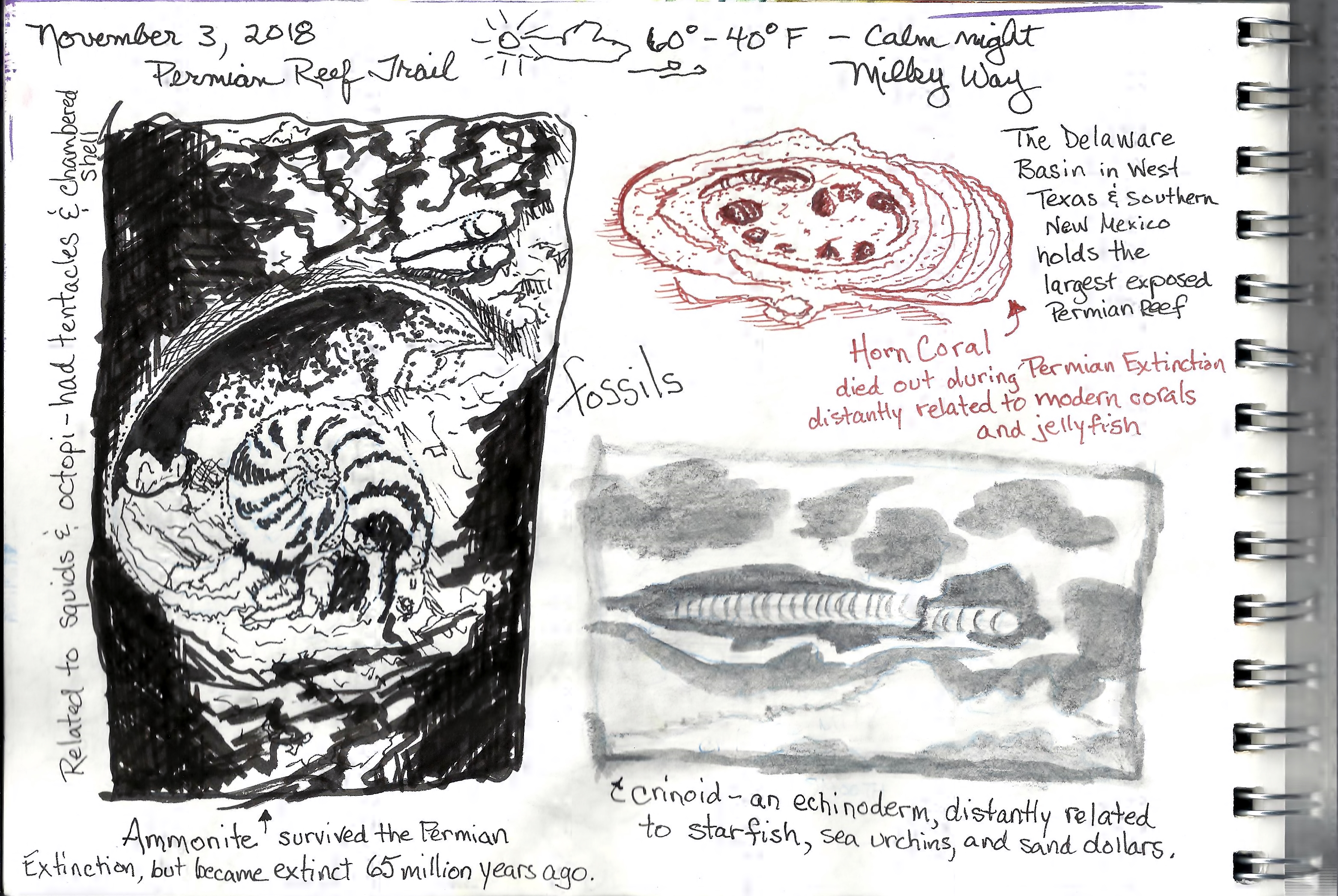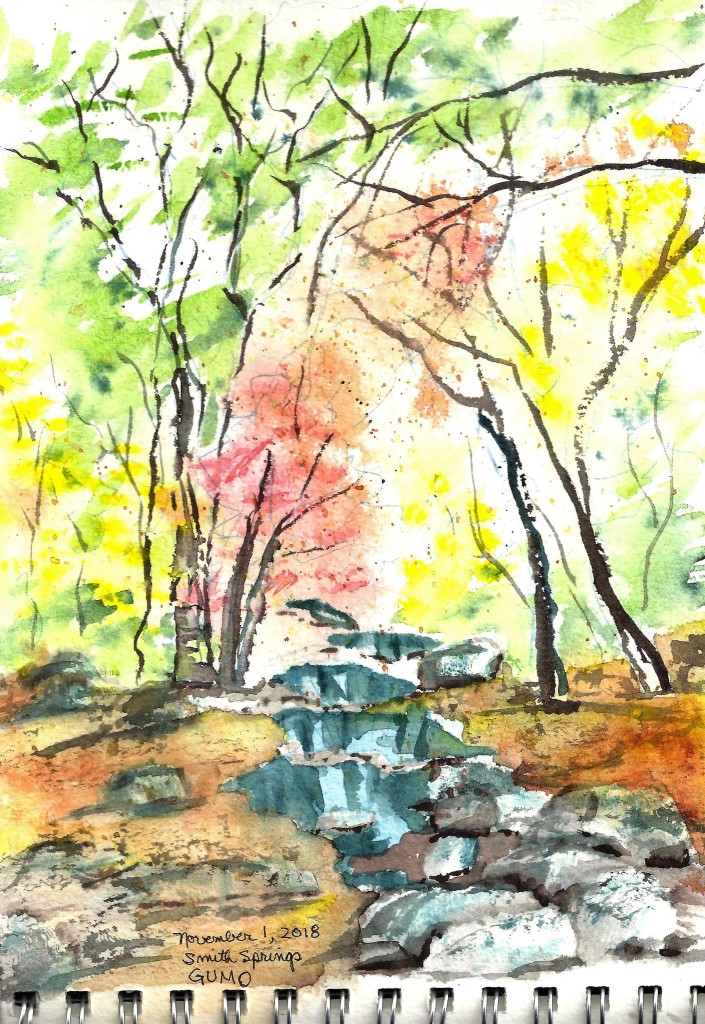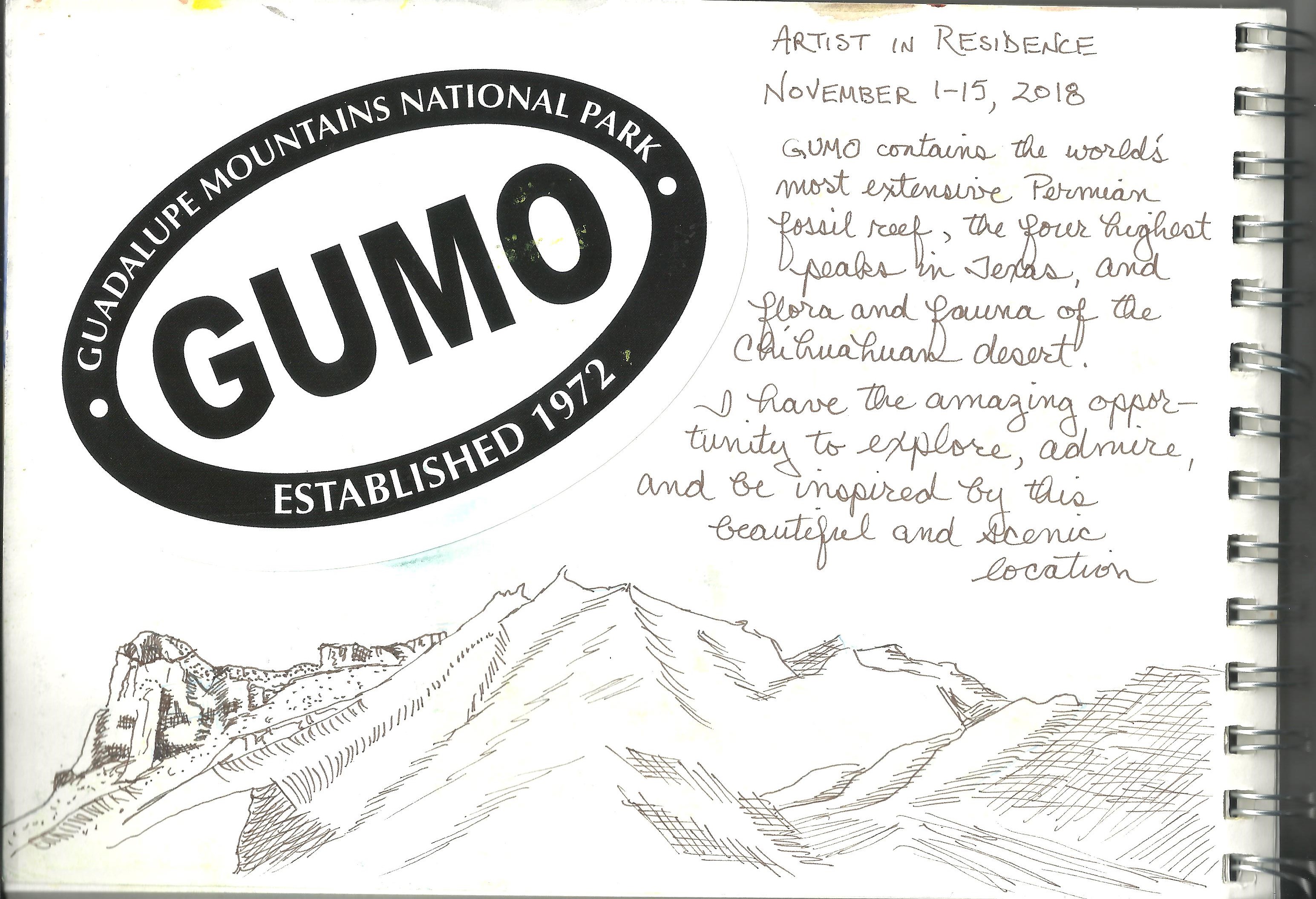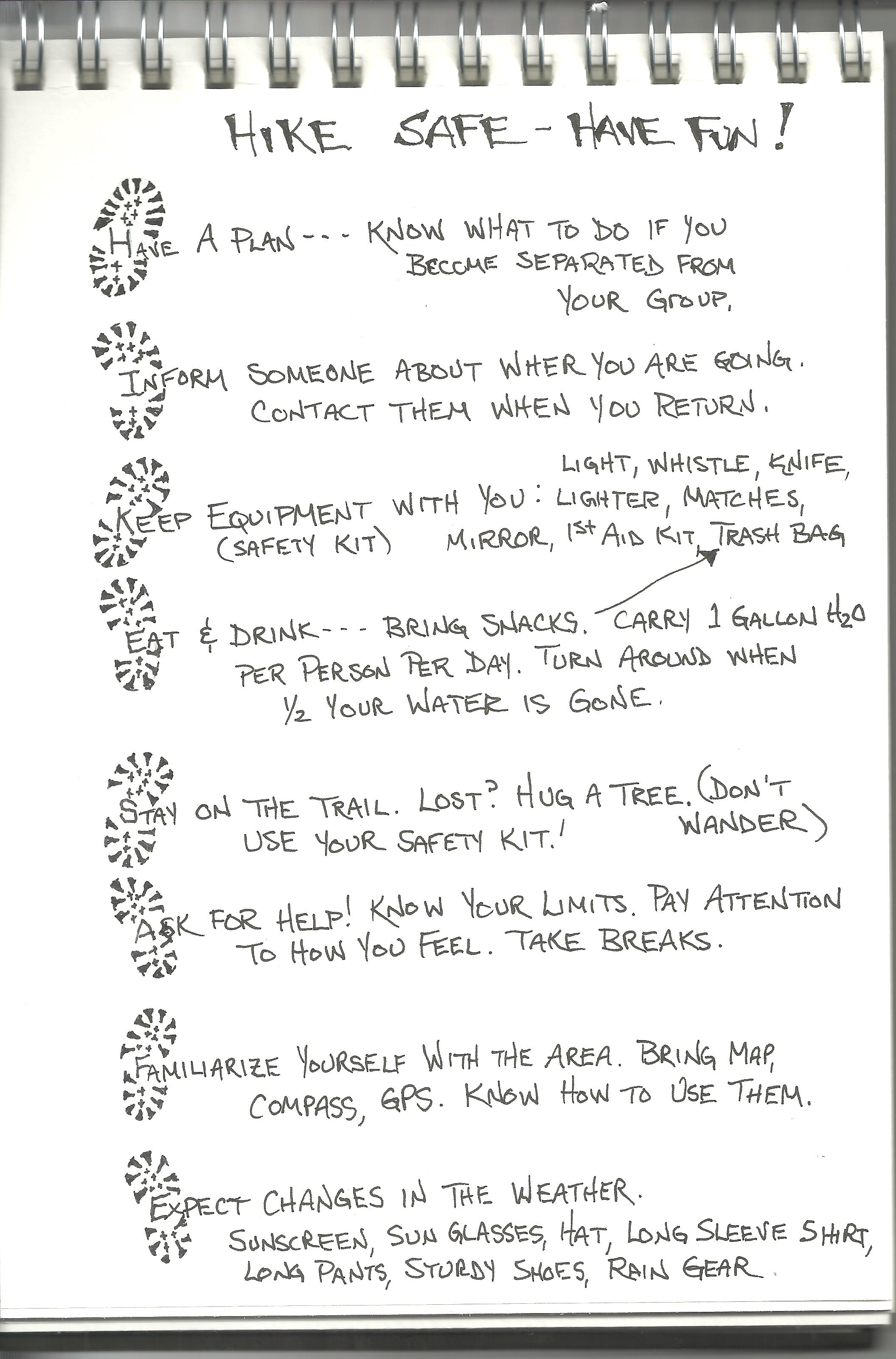“Hi Kat. The painting looks awesome. We don’t have anything like it in our collection. I know you sent me the dimensions, but I was happy to see it in person as a large arrangement of different scenes. It’s very impressive, and you hit on some of the most important reasons why this is a park. Well done, and thank you!”
Sincerely, Michael Haynie
Park Ranger, Guadalupe Mountains National Park
Final Project for the GUMO Artist in Residence Project. A full sheet (22″ x 30″) watercolor vignettes with Katlas journal entries. Matted and framed (30″ x 40″). Residency: November 1-15, 2018.









Devil’s Hall is a popular trail through a rocky stream bed. Devil’s Staircase and Devil’s Hall are some of the highlights along the way.


Painting in the lobby of the GUMO Visitor Center and on the trails, I met a lot of interesting people. McKattrick was one of the friendly staff members in the Visitor Center back office.

McKittrick Canyon is the autumn gem of the Guadalupe Mountains National Park. The Stone Cabin is one of the highlights in McKittrick Canyon. Visitors can enjoy the house and porch as a hike respite.
When the stock market crashed in 1929, Petroleum Geologist, Wallace Pratt bought out his partners and by 1930 he owned a major portion of the canyon. During the winter of 1931-32 he began construction of the home. Houston Architect John F. Staub designed the home. The cabin is made of only stone and wood. Heart-of-pine rafters, collar beams and sheathing to support the stone roof were shipped in from East Texas. The stone used in building the house was quarried outside the canyon at the base of the Guadalupe Mountains. Pratt selected “silty limestones, thin-bedded and closely jointed by clean vertical fractures.” Workers scraped off the thin layer of earth to reveal the proper stones, then using crowbars, levered the blocks apart. The joints made the blocks fit well, and Pratt noted that few required the stonemason’s hammer or chisel. With the depression on, good help could be hired inexpensively. Pratt hired Vance Phenix, a young architect displaced by the lack of projects. Phenix brought along his brother, Dean, a carpenter, and Adolph May, stonemason. Local ranchers Green McCombs and Alfred Lehman helped haul rock to the site and position materials.
By 1960, the Pratt’s bought property in Arizona and moved to Tucson. They began donating the family holdings in McKittrick Canyon to the National Park Service. Ultimately, the donations totaled over 5,000 acres.
An afternoon and evening walking around the dunes admiring the changing shadows on the mountain.


The Frijole History Museum documents all the people who lived in this area. The site includes a spring house, schoolhouse, bunkhouse, barn and picnic area. Frijole Spring provides the water essential for habitation. The first inhabitants of the area were the Nde’ (Apache). The Rader brothers built the first house in 1876. They raised cattle and never filed a deed. The house was abandoned when they moved on. In 1906, John Thomas Smith filed on the Frijole site as vacant land. He named it Spring Hill Ranch. The Smiths raised 10 children during their 36 years at the ranch. They had a 15 acre orchard and gardens to meet their dietary needs. In 1942, John Smith sold the Frijole Ranch to J.C. Hunter for $5000. Hunter incorporated the property into his commercial ranching operation. Noel Kincaid, Hunter’s ranch foreman occupied the house with his family until 1971 when their lease expired. J.C. Hunter Jr. inherited the ranch in 1945 and sold the 72,000 acre property to the National Park service in 1966. Guadalupe National Park was officially established in 1972. The first Park Ranger, Roger Reisch lived in the Frijole house from 1972 – 1980. It opened in 1992 as a history museum.

The Pinery ruins are what remain of a stagecoach station on the Butterfield Overland Mail route built in 1858. They can be reached directly off U.S. Route 62/180 or by a wheel-chair accessible 0.7 mile trail from the Guadalupe Mountains National Park (GUMO) Visitor Center.
For me, this was an easy walk for stargazing on clear, moonless nights. GUMO has begun to convert the park’s outdoor lighting systems to reduce sky glow and glare, the two forms in which light pollution exists. GUMO is seeking certification as a Dark Sky Park through the International Dark-Sky Association. You, your neighbors, and your community can make a difference by evaluating outdoor lighting and installing dark sky-friendly fixtures.
On my third day as an Artist in Residence in Guadalupe Mountains National Park (GUMO) I decided to spend three days backpacking on the Permian Reef Trail. This trail forms a segment of the Guadalupe Ridge Trail (GRT) and is 8.4 miles round trip with a 2,000 foot elevation gain. It’s a must hike trail for geology nerds. I had a fossil guide provided by the rangers at the Visitor Center. The steep climb was slow and easier because I was stopping frequently to find, identify, and read the unfolding geological story of the amazing fossils unveiled on the rock surfaces. Permian Reef Geology Guide.

The Guadalupe Mountains are among the best examples of a marine fossil reef. The reef was formed 206-270 million years ago. During that time, a tropical ocean covered portions of what is now known as Texas and New Mexico. Over millions of years, calcareous sponges, algae, and other lime-secreting marine organisms precipitated from the seawater. The marine life and lime built up to form the 400 mile, horseshoe-shaped Capitan Reef. Over millions of years, the sea evaporated, the reef subsided beneath sediments and mineral salts, an uplift exposed parts of the reef. Today, this ancient reef towers above the Chihuahua Desert in GUMO, the Apache Mountains, and Glass Mountains. https://en.wikipedia.org/wiki/Delaware_Basin
From the ridge line, I could see the fall foliage in McKittrick Canyon.

On day 2, I hiked the Wilderness Ridge Trail into Lincoln National Forest, NM – a segment of the GRT. https://www.fs.usda.gov/recarea/lincoln/recreation/recarea/?recid=34254&actid=51 The Guadalupe Ridge Trail was established in May 2017 by linking trail systems that were already in place. The GRT runs 100 miles from White’s City, NM and ends at Guadalupe Peak in Guadalupe Mountains N.P., TX. The trail is an extreme challenge even for experienced backpackers because of lack of reliable water sources and extreme elevation changes. Students from Carlsbad Early College High School (NM) took an active part in field mapping and marketing the newly designated trail. http://www.nrtdatabase.org/trailDetail.php?recordID=3935
On the trail, I saw the following:
Red-tailed Hawk (Buteo jamaicensis) https://www.desertusa.com/birds/red-tailed-hawk.html
Mule Deer (Odocoileus hemionus) https://www.desertusa.com/animals/mule-deer.html
Mountain Lion (Puma concolor) (skat and tracks only) https://www.desertusa.com/animals/mountain-lion.html
Barbary Sheep (Ammotragus lervia) http://www.tsusinvasives.org/home/database/ammotragus-lervia


SMITH SPRING is a 2.3 mile moderate hike (400’ elevation gain) in the Guadalupe Mountains. The trail is wheel chair accessible from Frijole Ranch to Manzanita Spring (.4 miles round trip). At the lower end of the trail, Prickly Pear, Agave, and Gray Oaks are the dominant plant species. Ponderosa Pine, Texas Madrone, and Big-toothed Maple trees make the riparian area a shady oasis. I was fortunate enough to visit during the color change of the Big-toothed Maples. Water is the essential element that allows people to inhabit the area. The animals, the Mescalero Apaches (Nde’), the Smith and Kincaid families, and now, park staff and visitors depend on this precious resource.
I arrived in Guadalupe Mountains National Park in the early afternoon and checked in at the Visitor Center. I was given a key to my apartment in employee quarters, a field radio, and a brief orientation to the park. After unloading the truck, I decided to hike to Smith Spring. After the hike, I drove to White’s City near Carlsbad Caverns to top off my gas tank. This park is pretty isolated and the nearest gasoline in 38 miles away.

I carry the Basics when I am backpacking. Ideal for car trips. Luxury if I’m going to stay in one place for a while.



A great start. Look forward to more.
LikeLike
This is truly amazing. Incredible renderings of light, reflection on water, colors on the trail. I like the way you were able to capture the shadows on the Guadalupe mountains. Each painting is different from the next; such diversity in the subject matter you chose to paint! I am a huge animal lover and of course I liked the page with the tarantula and the page with the barbary sheep. The way that you documented the fossils in the rock is also very beautiful; I felt as though I could almost see them myself. What is most impressive is that your love of nature and your inherent curiosity and sense of wonder are all wrapped up in the delicate, precise, yet unencumbered manner of getting that watercolor jumping on the paper. Such a great tale of your journey through the park; such a great way to share your talent and passion for hiking! Really impressive mastery of such a difficult medium of watercolor, wow.
LikeLike
Thank you Christine. Your support is encouraging.
LikeLike